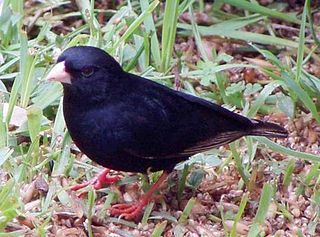
The International Union for Conservation of Nature (IUCN) Red List of Threatened Species, founded in 1964, is the world's most comprehensive inventory of the global conservation status of biological species. It uses a set of precise criteria to evaluate the extinction risk of thousands of species and subspecies. These criteria are relevant to all species and all regions of the world. With its strong scientific base, the IUCN Red List is recognized as the most authoritative guide to the status of biological diversity. A series of Regional Red Lists are produced by countries or organizations, which assess the risk of extinction to species within a political management unit.

The red-legged honeycreeper is a small songbird species in the tanager family (Thraupidae). It is found in the tropical New World from southern Mexico south to Peru, Bolivia and central Brazil, Trinidad and Tobago, and on Cuba, where possibly introduced. It is also rarely found in southern Texas.

The conservation status of a group of organisms indicates whether the group still exists and how likely the group is to become extinct in the near future. Many factors are taken into account when assessing conservation status: not simply the number of individuals remaining, but the overall increase or decrease in the population over time, breeding success rates, and known threats. Various systems of conservation status exist and are in use at international, multi-country, national and local levels as well as for consumer use.

The crested guan is a member of an ancient group of birds of the family Cracidae, which are related to the Australasian megapodes or mound builders (Megapodiidae). It is found in the Neotropics, in lowlands forests ranging from south Mexico and the Yucatán Peninsula to western Ecuador and southern Venezuela. The sexes are similar in appearance; the plumage is mainly dark brown with white spotting, an area of bare skin round the eye, bright red wattles, a bushy crest, a long broad tail and pink legs. It is a social bird, often seen in pairs or small family groups. It feeds in trees, mainly on fruit, and builds a nest of twigs on a branch. The two or three white eggs are incubated by the female. The International Union for Conservation of Nature has rated this bird's conservation status as "Near Threatened".

An IUCN Red List Critically Endangered (CR) species is one that has been categorized by the International Union for Conservation of Nature as facing an extremely high risk of extinction in the wild. As of 2021, of the 120,372 species currently tracked by the IUCN, there are 8,404 species that are considered to be Critically Endangered.

Ptisana purpurascens is a large fern belonging to the botanical family Marattiaceae. It has a globular rhizome with stipule-like fleshy outgrowths. The leaves are dark green, twice pinnate and up to 1 metre long. Every pinnule has up to six pairs of leaflets. The petioles are dark-purplish, hence the name 'purpurascens' meaning 'becoming purple'. The sporangia are fused in all Ptisana into a bivalvate synangium.

Dalbergia purpurascens is a species of legume in the family Fabaceae.

The dusky indigobird, variable indigobird, or black widowfinch is a species of bird in the family Viduidae. It is found in Angola, Burundi, Cameroon, Republic of the Congo, Democratic Republic of the Congo, Guinea-Bissau, Malawi, Mozambique, Nigeria, Sierra Leone, South Africa, Swaziland, Tanzania, Zambia, and Zimbabwe. Its natural habitat is moist savanna.

The purple indigobird is a species of bird in the family Viduidae. It is also known as the dusky indigobird, a name which can refer to Vidua funerea. It is found in Angola, Botswana, Democratic Republic of the Congo, Kenya, Malawi, Mozambique, South Africa, Tanzania, Zambia, and Zimbabwe. Its natural habitat is dry savanna.
Aegiphila purpurascens is a species of tree in the family Lamiaceae. It is endemic to Azuay Province in Ecuador, where only three populations are known. It grows in the cloud forests of the Andes at 2000 to 3000 meters in elevation.
Hedyosmum purpurascens is a species of plant in the Chloranthaceae family. It is endemic to Ecuador. Its natural habitat is subtropical or tropical moist montane forests.
Keetia bakossiorum is a species of flowering plant in the family Rubiaceae. It is endemic to Cameroon. Its natural habitats are subtropical or tropical moist lowland forests and subtropical or tropical moist montane forests. It is threatened by habitat loss.
Keetia is a genus of flowering plants in the family Rubiaceae. It consists of climbers or scrambling shrubs, rarely small trees.
Keetia koritschoneri is a species of plant in the family Rubiaceae. It is endemic to Tanzania.
Metastelma purpurascens is a species of plant in the family Apocynaceae. It is endemic to Ecuador. Its natural habitat is subtropical or tropical moist montane forests. It is threatened by habitat loss.
Stenocarpus villosus is a species of plant in the family Proteaceae. It is endemic to New Caledonia. It is threatened by habitat loss.
Grevillea molyneuxii, commonly known as the Wingello grevillea, is a shrub which is endemic to the shrublands of New South Wales in Australia.

The brown kukri snake is a species of snake of the family Colubridae.
The purplish dtella is a species of gecko endemic to Australia.
Magnolia tarahumara is a species of flowering plant in the family Magnoliaceae. It is endemic to Mexico, where it occurs in scattered locations in the Sierra Madre Occidental of southeastern Sonora, southwestern Chihuahua, Sinaloa, and northwestern Durango.









